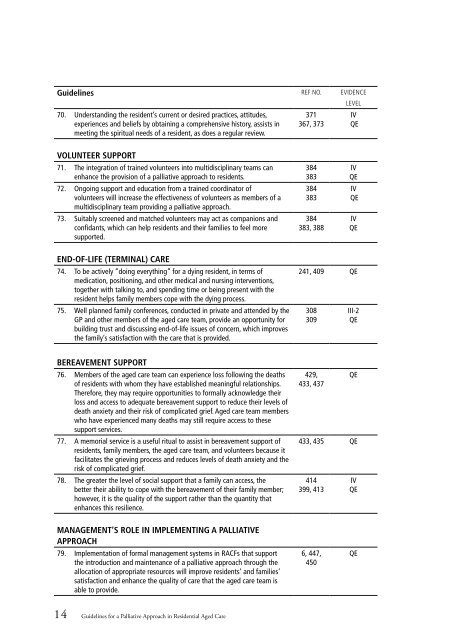Guidelines for a Palliative Approach in Residential Aged Care
Guidelines for a Palliative Approach in Residential Aged Care
Guidelines for a Palliative Approach in Residential Aged Care
You also want an ePaper? Increase the reach of your titles
YUMPU automatically turns print PDFs into web optimized ePapers that Google loves.
<strong>Guidel<strong>in</strong>es</strong> Ref No. Evidence<br />
70. Understand<strong>in</strong>g the resident’s current or desired practices, attitudes,<br />
experiences and beliefs by obta<strong>in</strong><strong>in</strong>g a comprehensive history, assists <strong>in</strong><br />
meet<strong>in</strong>g the spiritual needs of a resident, as does a regular review.<br />
371<br />
367, 373<br />
level<br />
IV<br />
QE<br />
VOLUNTEER SUPPORT<br />
71. The <strong>in</strong>tegration of tra<strong>in</strong>ed volunteers <strong>in</strong>to multidiscipl<strong>in</strong>ary teams can<br />
enhance the provision of a palliative approach to residents.<br />
72. Ongo<strong>in</strong>g support and education from a tra<strong>in</strong>ed coord<strong>in</strong>ator of<br />
volunteers will <strong>in</strong>crease the effectiveness of volunteers as members of a<br />
multidiscipl<strong>in</strong>ary team provid<strong>in</strong>g a palliative approach.<br />
73. Suitably screened and matched volunteers may act as companions and<br />
confidants, which can help residents and their families to feel more<br />
supported.<br />
384<br />
383<br />
384<br />
383<br />
384<br />
383, 388<br />
IV<br />
QE<br />
IV<br />
QE<br />
IV<br />
QE<br />
END-OF-LIFE (TERMINAL) CARE<br />
74. To be actively “do<strong>in</strong>g everyth<strong>in</strong>g” <strong>for</strong> a dy<strong>in</strong>g resident, <strong>in</strong> terms of<br />
medication, position<strong>in</strong>g, and other medical and nurs<strong>in</strong>g <strong>in</strong>terventions,<br />
together with talk<strong>in</strong>g to, and spend<strong>in</strong>g time or be<strong>in</strong>g present with the<br />
resident helps family members cope with the dy<strong>in</strong>g process.<br />
75. Well planned family conferences, conducted <strong>in</strong> private and attended by the<br />
GP and other members of the aged care team, provide an opportunity <strong>for</strong><br />
build<strong>in</strong>g trust and discuss<strong>in</strong>g end-of-life issues of concern, which improves<br />
the family’s satisfaction with the care that is provided.<br />
241, 409 QE<br />
308<br />
309<br />
III-2<br />
QE<br />
BEREAVEMENT SUPPORT<br />
76. Members of the aged care team can experience loss follow<strong>in</strong>g the deaths<br />
of residents with whom they have established mean<strong>in</strong>gful relationships.<br />
There<strong>for</strong>e, they may require opportunities to <strong>for</strong>mally acknowledge their<br />
loss and access to adequate bereavement support to reduce their levels of<br />
death anxiety and their risk of complicated grief. <strong>Aged</strong> care team members<br />
who have experienced many deaths may still require access to these<br />
support services.<br />
77. A memorial service is a useful ritual to assist <strong>in</strong> bereavement support of<br />
residents, family members, the aged care team, and volunteers because it<br />
facilitates the griev<strong>in</strong>g process and reduces levels of death anxiety and the<br />
risk of complicated grief.<br />
78. The greater the level of social support that a family can access, the<br />
better their ability to cope with the bereavement of their family member;<br />
however, it is the quality of the support rather than the quantity that<br />
enhances this resilience.<br />
429,<br />
433, 437<br />
QE<br />
433, 435 QE<br />
414<br />
399, 413<br />
IV<br />
QE<br />
MANAGEMENT’S ROLE IN IMPLEMENTING A PALLIATIVE<br />
APPROACH<br />
79. Implementation of <strong>for</strong>mal management systems <strong>in</strong> RACFs that support<br />
the <strong>in</strong>troduction and ma<strong>in</strong>tenance of a palliative approach through the<br />
allocation of appropriate resources will improve residents’ and families’<br />
satisfaction and enhance the quality of care that the aged care team is<br />
able to provide.<br />
6, 447,<br />
450<br />
QE<br />
14 <strong>Guidel<strong>in</strong>es</strong> <strong>for</strong> a <strong>Palliative</strong> <strong>Approach</strong> <strong>in</strong> <strong>Residential</strong> <strong>Aged</strong> <strong>Care</strong>
















